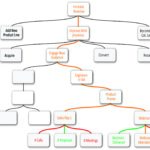[et_pb_section fb_built=”1″ _builder_version=”4.8.2″ _module_preset=”default”][et_pb_row _builder_version=”4.8.2″ _module_preset=”default”][et_pb_column type=”4_4″ _builder_version=”4.8.2″ _module_preset=”default”][et_pb_text _builder_version=”4.8.2″ _module_preset=”default”]
OKRs (Objectives and Key Results) and KPIs (Key Performance Indicators) are widely used in companies to measure performance. But what is the difference between OKRs and KPIs? In this blog post, I will explain what OKRs and KPIs are, how they differ from each other, and why they are both important for any company. And we will explain how KPI Karta straddles both OKRs and KPIs and make them stronger.
KPI (Key performance indicators) Definition
A KPI is a metric that informs how your business is doing. Many people confuse measures and metrics, so let’s define them:
A measure is a number that is derived from taking a measurement. A measure is the observed value of a number at a point in time. Measures are raw numbers and data points found in data or reports; often in corporate databases, call centers and other data silos. On their own, measures deliver little value.
A Metric is a calculated number derived or calculated from measures. Ideally, it should be expressed as a ratio, average, percentage, or rate.
For example, ‘in-store visitors’ is a measure, while the ‘percentage increase of in-store visitors’ is a metric. Simply knowing how many visitors we had at a point in time delivers no real insight unless we know how many we had before. The calculation to arrive at the metric does that for us. So, by monitoring the metric we better understand how to store traffic is changing. That may be very important to know when evaluating how promotional programs are driving customers to stores.
Since there are hundreds or even thousands of measures and metrics produced in our daily corporate lives, KPIs should only focus on the ones that are essential or impactful to business performance measurement. A KPI, as the name implies, measures critical items that are necessary for success. They should monitor actions and events that tell you about performance.
OKR (Objective and Key Results) Definition
OKRs is a goal-setting framework that helps you focus on what is important, align your team, and set goals that are measurable. OKRs are written with an Objective at the top and 3-5 supporting Key Results below it. They can also be written as a statement:
We will (Objective) as measured by (Key Results).
An Objective is simply what is to be achieved, no more and no less. By definition, Objectives are significant, concrete, and action oriented. When properly designed and deployed, they’re a vaccine against fuzzy thinking and ineffective execution.
Key Results benchmark and monitor how we get to the Objective. Effective KRs are specific, time-bound, and aggressive yet realistic. Most of all, they are measurable and verifiable.
Example:
Sales team Objective: Increase monthly sales revenue
Key Result 1: improve average subscription value to $900 per month
Key Result 2: adjust lead scoring parameters to prioritize larger deals
Key Result 3: increase percentage of high-value leads generated from 20% to 30%
The issue with OKRs is that it isn’t obvious how or why those specific Results will lead to accomplishing the set Objective. While Objectives and Results can be made to roll up to the next level and connect to others in a hierarchy, teams are often encouraged to set their own Objectives and Results, but the the alignment of disparate teams isn’t obvious. As Bernard Marr of David Marr & Co. states: “if every team is designing their own OKRs, overall alignment with the top organizational priorities can be lost.”
KRI (Key Results Indicators) Definition
A term that is often missed are Key Results Indicators. KRIs measure the results from your many business actions, whereas KPIs track specific actions or activities. Don’t confuse the two. KPIs don’t measure goals; KRIs do.
Unlike KPIs, which measure the precise actions we take to obtain certain results, KRIs report on results of many activities, are backward looking and inform what has happened.
KRIs measure the effect of business activities but ignore the cause. Product sales, new customers, and even revenue are KRIs and only inform how you did but not why. For that we need to establish KPIs.
The reason we make the distinction is that many people incorrectly track the results of many actions or activities and call them KPIs. It’s certainly important to track goals, but you don’t know what caused the goal to be reached or not if you don’t track the actions or activities that align with those goals. For that you need to establish KPIs.
Recommended Read: Steps to measure the Cause of your Results
Sales Revenue is not a KPI
Sales Revenue is not a KPI, rather it’s a KRI. You can’t look at a change in sales revenue and know what specific action to take because there are many factors which contributed to that number. They could be the number of outbound or inbound sales calls made, leads generated from a new ad campaign, upgrade offers made, production issues, delivery problems, etc. Obviously, Sales Revenue is of interest but it’s not a KPI because it’s not an actionable value that directly informs what happened. KPIs should instead be assigned to the specific actions listed above to see when they perform differently so you can take direct action. Tying KPIs to specific activities drives acceptance of using them and when people see that what they are doing directly affects the overall goal and that what they are doing has direct value, they buy into the process.
How KPI Karta bridges the gap
As we can see, OKRs and KRIs measure goals or what you are trying to achieve. KPIs do not. They are instead tracking the very specific things necessary to achieve the goal. But the problem with OKRs is that the Results for the Objective doesn’t connect to the activities we do. OKRs say: “here are the Results I expect from you” but it doesn’t instruct how to achieve them. That’s where KPI Karta bridges the gap by detailing the very specific activities that will get you the desired result and ultimately achieve the Objective or Goal.
KPI Karta enables users to figure out what to measure. KPI Karta lays out a methodology for establishing an Objective or Goal and builds a hierarchical map describing the necessary steps to take. As an example, for a marketing and sales team, that includes identifying the Critical things that are necessary to accomplish the goal, what the Marketing phase we are in (recruiting for new customers, upselling existing ones, and so on), what the Segment is of your target customer, what the overall Approach is that you want to take, and then what specific Activities you will do to get there. We then assign KPI values to those activities. We can then “see” how we are performing by tracking the set KPIs. Just as is prescribed with OKRs, this information is shared with the organization so everyone understands who is responsible for specific tasks and can understand how we are performing at all times.
KPI Karta provides the connective tissue of why we need to perform specific tasks
[/et_pb_text][/et_pb_column][/et_pb_row][/et_pb_section][et_pb_section fb_built=”1″ _builder_version=”4.8.2″ _module_preset=”default” custom_margin=”-140px||||false|false”][et_pb_row _builder_version=”4.8.2″ _module_preset=”default”][et_pb_column type=”4_4″ _builder_version=”4.8.2″ _module_preset=”default”][et_pb_image src=”https://www.kpikarta.com/wp-content/uploads/2023/02/KPIK-Map.jpg” title_text=”KPIK Map” _builder_version=”4.8.2″ _module_preset=”default”][/et_pb_image][/et_pb_column][/et_pb_row][/et_pb_section][et_pb_section fb_built=”1″ _builder_version=”4.8.2″ _module_preset=”default” custom_margin=”-126px||||false|false”][et_pb_row _builder_version=”4.8.2″ _module_preset=”default”][et_pb_column type=”4_4″ _builder_version=”4.8.2″ _module_preset=”default”][et_pb_text _builder_version=”4.8.2″ _module_preset=”default”]
Conclusion
OKRs are used for setting and attaining Goals, while KPIs are targets for specific actions or activities. Often KPIs are mistakenly assigned to high-level goals. Those are instead KRIs. While OKR models attempt to align objectives among teams and describe them in hierarchical structures, they don’t explain why specific Results are relevant. Instead, KPI Karta delivers a better understanding of why we need to perform certain tasks and how they are critical in reaching established goals.
[/et_pb_text][/et_pb_column][/et_pb_row][/et_pb_section]






